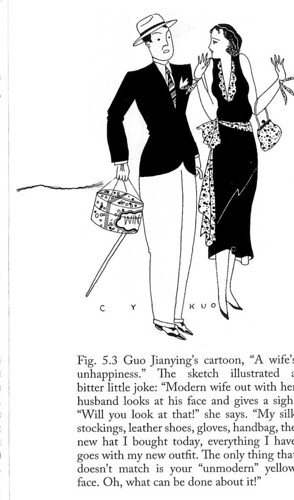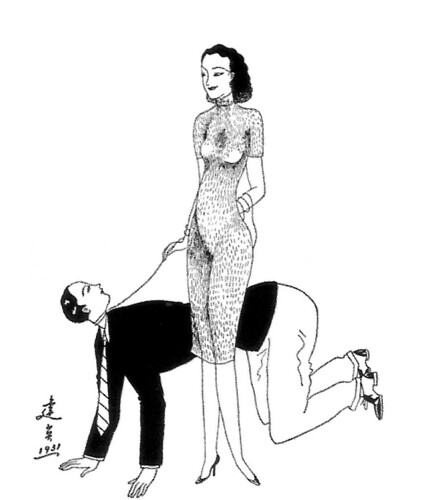Antonia Finnane’s new book1 on modern Chinese fashion is very good in all sorts of ways, but I was struck by a couple of cartoons by Guo Jianying. The first is rather funny, and centers around the husband as a consumer good.

The second is more purely misogynist

Guo was a pretty important figure, editor of the Woman’s Pictorial. He also seems to have not much cared for women, or perhaps had a specific dislike for women as part of a general dislike of humanity. I find it sort of interesting that he seems to be reproducing Western criticism of “uppity” women almost exactly. One part of making China modern was importing modern concepts about gender roles, and here Guo has imported a pretty western version of sexism.
Finnane, Antonia. Changing Clothes in China: Fashion, History, Nation. Columbia University Press, 2007. ↩
Interesting post. I have with me Finnane’s book as well, and a book edited by Chen Zishan 陳子善 called Shanghai Modern (not to be confused with Leo Lee’s publication). Chen Zishan is an expert on Shanghai and the works of Eileen Chang and teaches at Shanghai’s “Huadong Shifan”. Chen’s book is basically a Guo Jianying collection, with some analysis on the side. Guo Jianying’s cartoons definitely display an anxiety about the New Woman and the Modern Girl — the New Woman, because of their relative independence and education, a threat to masculinity, meanwhile the Modern Girl, because of their cunningness, their greed etc. would “suck a man dry”. There’s also the worry that one can’t tell the difference between “normal, respectable woman” and prostitutes, because they all dress and behave alike (and the equation that all Modern Girls are really just whores). So there’s suddenly this yearning in the 1930s for the “good”, “chaste” wife who stays at home, who supports the husband etc. — a backlash. You can see this in Chinese discussion of George Bernard Shaw’s play “Pygmalion” (1912). The story, of course: Henry Higgins (Chinese intellectuals?) “makes” Eliza Doolittle (New Women?), and then Eliza Doolittle becomes independently-minded and leaves him because he’s a totally patronising jerk. In Shaw’s original, Eliza *doesn’t* come back, this ending was changed to a happy one in “My Fair Lady”!
Leon,
Yes, I think what Guo Jianying is talking about here is the sort of post-May 4th bourgeois New Woman that Glosser and Haiyan Lee wrote about. Having not seen all of his stuff I am not sure where to put him, but at least from these pictures he does not seem to imply that the proper woman is more domestic (as the people Glosser wrote about did). I don’t think the guy in the first cartoon is wishing his woman was home caring for the kids. At least from the pictures it looks like Esquire or GQ or the New Yorker or something. (My reading of magazines for males petered out around Boy’s Life) Sexualized women are fine, modern consumerist women are fine, they just need to know their place.